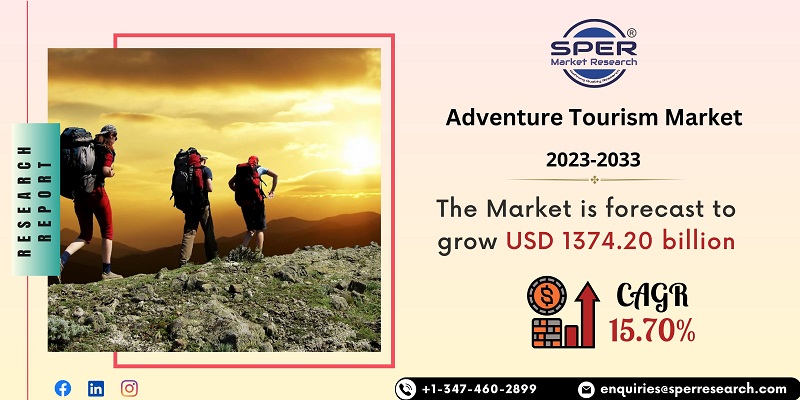
Adventure Tourism Market Growth, Size, Trends, Share, Demand, Revenue and Future Outlook
Global Adventure Tourism Market Size- By Type, By Activity, By Type of Traveller, By Booking Mode, By Age Group- Regional Outlook, Competitive Strategies and Segment Forecast to 2033
| Published: Apr-2023 | Report ID: TRAT2306 | Pages: 1 - 234 | Formats*: |
| Category : Travel & Tourism | |||


| Report Metric | Details |
| Market size available for years | 2019-2033 |
| Base year considered | 2022 |
| Forecast period | 2023-2033 |
| Segments covered | By Type, By Activity, By Type of Traveller, By Booking Mode, By Age Group |
| Regions covered | Asia-Pacific, Europe, the Middle East and Africa, North America, and Latin America |
| Companies Covered | Austin Adventures, Inc., Butterfield & Robinson Inc., Cox & Kings Ltd., Discovery Nomads, G Adventures, Geographic Expeditions Inc., Intrepid Group, Itd., Mountain Travel Sobek, Tui Group, Others |
- Adventure Seekers
- Cultural Explorers
- Eco-Tourists
- Family Travelers
- Nature Enthusiasts
- Outdoor Sports Enthusiasts
- Solo Travelers and Backpackers
- Global Adventure Tourism Market Value Share and Forecast, By Type, 2023-2033
- Hard
- Soft
- Others
- Global Adventure Tourism Market Value Share and Forecast, By Activity, 2023-2033
- Air-based Activity
- Land-based Activity
- Water-based Activity
- Global Adventure Tourism Market Value Share and Forecast, By Type of Traveller, 2023-2033
- Couples
- Family
- Friends/Groups
- Solo
- Global Adventure Tourism Market Value Share and Forecast, By Booking Mode, 2023-2033
- Direct
- Marketplace Booking
- Travel Agent
- Asia-Pacific
- Europe
- Middle East & Africa
- North America
- Latin America
- Global Adventure Tourism Market Size (FY’2023-FY’2033)
- Overview of Global Adventure Tourism Market
- Segmentation of Global Adventure Tourism Market By Type (Hard, Soft, Others)
- Segmentation of Global Adventure Tourism Market By Activity (Air-based Activity, Land-based Activity, Water-based Activity)
- Segmentation of Global Adventure Tourism Market By Type of Traveller (Couples, Family, Friends/Groups, Solo)
- Segmentation of Global Adventure Tourism Market By Booking Mode (Direct, Marketplace Booking, Travel Agent)
- Segmentation of Global Adventure Tourism Market By Age Group (Below 30 years, 30–41 years, 42–49 years, 50 years and above)
- Statistical Snap of Global Adventure Tourism Market
- Growth Analysis of Global Adventure Tourism Market
- Problems and Challenges in Global Adventure Tourism Market
- Competitive Landscape in the Global Adventure Tourism Market
- Impact of COVID-19 and Demonetization on Global Adventure Tourism Market
- Details on Recent Investment in Global Adventure Tourism Market
- Competitive Analysis of Global Adventure Tourism Market
- Key Players in the Global Adventure Tourism Market
- SWOT Analysis of Global Adventure Tourism Market
- Global Adventure Tourism Market Future Outlook and Projections (FY’2023-FY’2033)
- Recommendations from Analyst
1.1. Scope of the report1.2. Market segment analysis
2.1. Research data source2.1.1. Secondary Data2.1.2. Primary Data2.1.3. SPER’s internal database2.1.4. Premium insight from KOL’s2.2. Market size estimation2.2.1. Top-down and Bottom-up approach2.3. Data triangulation
4.1. Driver, Restraint, Opportunity and Challenges analysis4.1.1. Drivers4.1.2. Restraints4.1.3. Opportunities4.1.4. Challenges4.2. COVID-19 Impacts of the Global Adventure Tourism Market
5.1. SWOT Analysis5.1.1. Strengths5.1.2. Weaknesses5.1.3. Opportunities5.1.4. Threats5.2. PESTEL Analysis5.2.1. Political Landscape5.2.2. Economic Landscape5.2.3. Social Landscape5.2.4. Technological Landscape5.2.5. Environmental Landscape5.2.6. Legal Landscape5.3. PORTER’s Five Forces5.3.1. Bargaining power of suppliers5.3.2. Bargaining power of buyers5.3.3. Threat of Substitute5.3.4. Threat of new entrant5.3.5. Competitive rivalry5.4. Heat Map Analysis
6.1. Global Adventure Tourism Market Manufacturing Base Distribution, Sales Area, Product Type6.2. Mergers & Acquisitions, Partnerships, Product Launch, and Collaboration in Global Adventure Tourism Market
7.1. Global Adventure Tourism Market Value Share and Forecast, By Type, 2023-20337.2. Hard7.3. Soft7.4. Others
8.1. Global Adventure Tourism Market Value Share and Forecast, By Activity, 2023-2033
8.2. Air-based Activity
8.3. Land-based Activity8.3.1. Camping8.3.2. Jungle Safari8.3.3. Trekking and Mountain Climbing8.4. Water-based Activity
9.1. Global Adventure Tourism Market Value Share and Forecast, By Type of Traveller, 2023-20339.2. Couples9.3. Family9.4. Friends/Groups9.5. Solo
10.1. Global Adventure Tourism Market Value Share and Forecast, By Booking Mode, 2023-203310.2. Direct10.3. Marketplace Booking10.4. Travel Agent
11.1. Global Adventure Tourism Market Value Share and Forecast, By Age Group, 2023-203311.2. Below 30 years11.3. 30–41 years11.4. 42–49 years11.5. 50 years and above
12.1. Global Adventure Tourism Market Size and Market Share
13.1. Global Adventure Tourism Market Size and Market Share By Type (2019-2026)13.2. Global Adventure Tourism Market Size and Market Share By Type (2027-2033)
14.1. Global Adventure Tourism Market Size and Market Share By Activity (2019-2026)14.2. Global Adventure Tourism Market Size and Market Share By Activity (2027-2033)
15.1. Global Adventure Tourism Market Size and Market Share By Type of Traveller (2019-2026)15.2. Global Adventure Tourism Market Size and Market Share By Type of Traveller (2027-2033)
16.1. Global Adventure Tourism Market Size and Market Share By Booking Mode (2019-2026)16.2. Global Adventure Tourism Market Size and Market Share By Booking Mode (2027-2033)
17.1. Global Adventure Tourism Market Size and Market Share By Age Group (2019-2026)17.2. Global Adventure Tourism Market Size and Market Share By Age Group (2027-2033)
18.1. Global Adventure Tourism Market Size and Market Share By Region (2019-2026)18.2. Global Adventure Tourism Market Size and Market Share By Region (2027-2033)18.3. Asia-Pacific18.3.1. Australia18.3.2. China18.3.3. India18.3.4. Japan18.3.5. South Korea18.3.6. Rest of Asia-Pacific18.4. Europe18.4.1. France18.4.2. Germany18.4.3. Italy18.4.4. Spain18.4.5. United Kingdom18.4.6. Rest of Europe18.5. Middle East and Africa18.5.1. Kingdom of Saudi Arabia18.5.2. United Arab Emirates18.5.3. Rest of Middle East & Africa18.6. North America18.6.1. Canada18.6.2. Mexico18.6.3. United States18.7. Latin America18.7.1. Argentina18.7.2. Brazil18.7.3. Rest of Latin America
19.1. Austin Adventures, Inc.19.1.1. Company details19.1.2. Financial outlook19.1.3. Product summary19.1.4. Recent developments19.2. Butterfield & Robinson Inc.19.2.1. Company details19.2.2. Financial outlook19.2.3. Product summary19.2.4. Recent developments19.3. Cox & Kings Ltd.19.3.1. Company details19.3.2. Financial outlook19.3.3. Product summary19.3.4. Recent developments19.4. Discovery Nomads19.4.1. Company details19.4.2. Financial outlook19.4.3. Product summary19.4.4. Recent developments19.5. G Adventures19.5.1. Company details19.5.2. Financial outlook19.5.3. Product summary19.5.4. Recent developments19.6. Geographic Expeditions Inc.19.6.1. Company details19.6.2. Financial outlook19.6.3. Product summary19.6.4. Recent developments19.7. Intrepid Group, Itd.19.7.1. Company details19.7.2. Financial outlook19.7.3. Product summary19.7.4. Recent developments19.8. Mountain Travel Sobek19.8.1. Company details19.8.2. Financial outlook19.8.3. Product summary19.8.4. Recent developments19.9. Tui Group19.9.1. Company details19.9.2. Financial outlook19.9.3. Product summary19.9.4. Recent developments19.10. Others
SPER Market Research’s methodology uses great emphasis on primary research to ensure that the market intelligence insights are up to date, reliable and accurate. Primary interviews are done with players involved in each phase of a supply chain to analyze the market forecasting. The secondary research method is used to help you fully understand how the future markets and the spending patterns look likes.
The report is based on in-depth qualitative and quantitative analysis of the Product Market. The quantitative analysis involves the application of various projection and sampling techniques. The qualitative analysis involves primary interviews, surveys, and vendor briefings. The data gathered as a result of these processes are validated through experts opinion. Our research methodology entails an ideal mixture of primary and secondary initiatives.



Frequently Asked Questions About This Report
PLACE AN ORDER
Year End Discount
Sample Report
Pre-Purchase Inquiry
NEED CUSTOMIZATION?
Request CustomizationCALL OR EMAIL US
100% Secure Payment






Related Reports
Our Global Clients
Our data-driven insights have influenced the strategy of 200+ reputed companies across the globe.






















